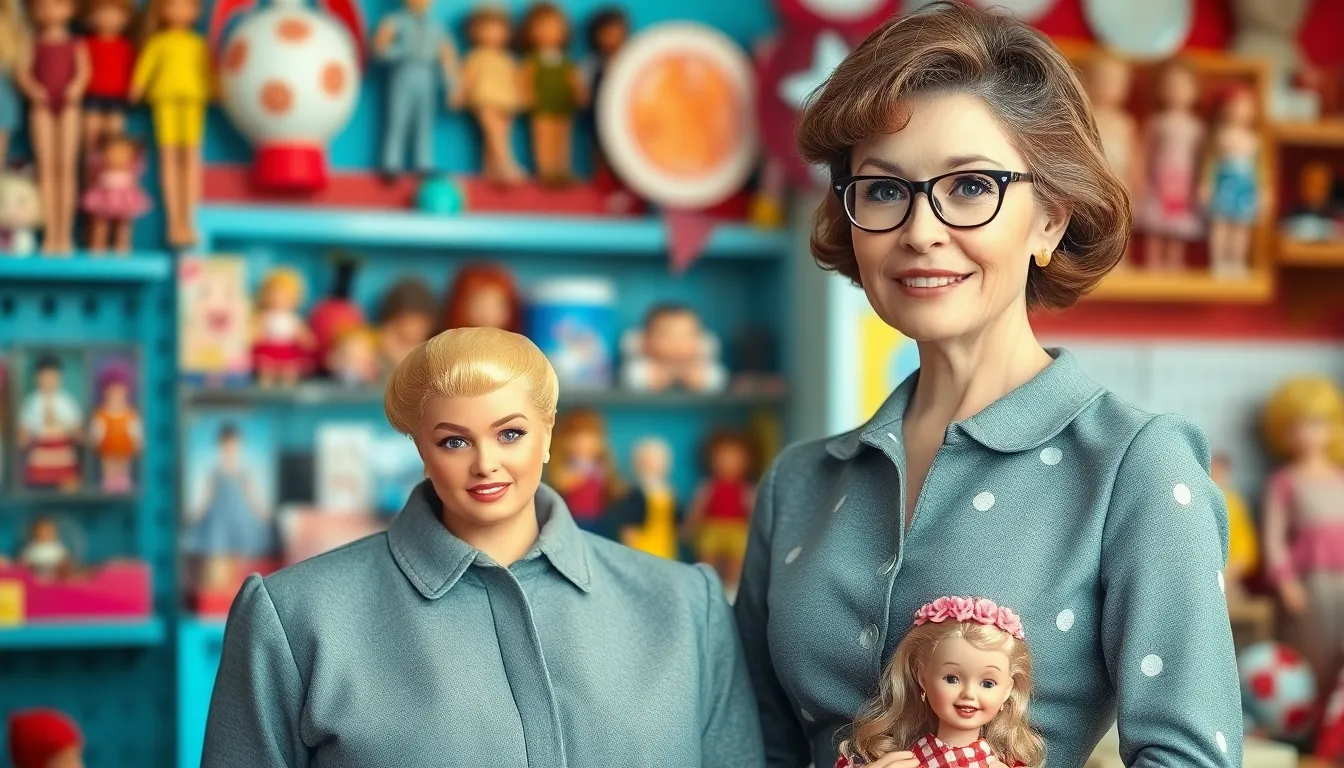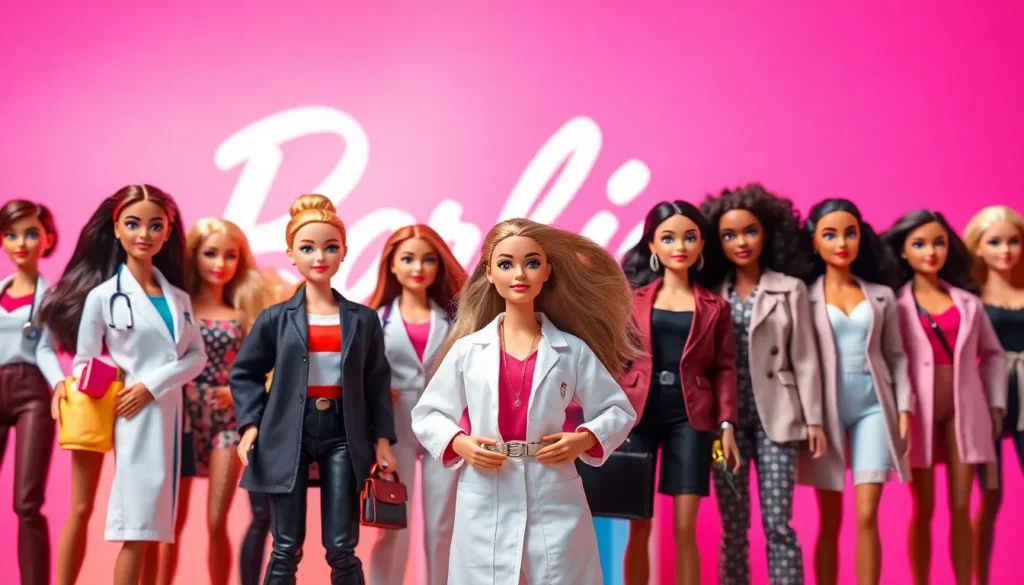Table of Contents
ToggleRuth Handler is a name that resonates deeply within the world of Barbie. As the co-founder of Mattel and the creative mind behind the iconic doll, she played a pivotal role in shaping not just a toy but a cultural phenomenon. Ruth’s vision was to create a doll that would inspire girls to imagine their futures and explore diverse roles beyond traditional expectations.
Born in 1916, Ruth’s journey began with a simple idea that transformed into a multi-billion dollar brand. Her innovative approach to design and marketing set the stage for Barbie’s evolution over the decades. Understanding the impact of representation, Ruth ensured that Barbie could embody various careers and lifestyles, making her a symbol of empowerment for generations of girls. Discovering Ruth’s story reveals the passion and creativity that fueled the legacy of Barbie, making her an essential figure in this beloved narrative.
Who Is Ruth in Barbie
Ruth Handler, co-founder of Mattel, played a pivotal role in creating Barbie. Born in 1916, Ruth’s vision aimed to empower girls by providing a role model beyond traditional limitations. She conceptualized Barbie in 1959 as a fashion doll with diverse possibilities, encouraging imagination.
Ruth recognized that girls needed a figure that represented multiple careers and lifestyles. Her innovative marketing approach positioned Barbie as not just a toy, but a cultural icon. Under her guidance, Barbie showcased professions like astronaut, doctor, and president, reflecting women’s growing presence in various fields.
Ruth’s passion for design and storytelling reshaped children’s play. Her influence extended beyond Barbie, advocating for women in the toy industry, highlighting gender equality. Ruth Handler’s legacy remains deeply intertwined with Barbie, illustrating how play can inspire generations to dream big and pursue their ambitions.
The Historical Context of Ruth Handler

Ruth Handler’s life and achievements significantly shaped the toy industry and modern culture. Her vision for a new kind of doll transformed children’s play and female representation.
Early Life and Background
Ruth Handler was born on November 4, 1916, in Denver, Colorado. She grew up in a Jewish family, where her entrepreneurial spirit began to emerge early. After working in her family’s business, Ruth attended college briefly before marrying Elliot Handler in 1938. They co-founded Mattel in 1945, initially producing picture frames. Ruth’s interest in toys grew as she noticed the lack of dolls that represented adult women. Her personal experiences as a mother encouraged her to create a toy that allowed young girls to imagine broader futures.
The Creation of Barbie
In 1959, Ruth Handler introduced Barbie at the American International Toy Fair. The doll was designed to embody freedom, independence, and numerous career possibilities. Unlike traditional baby dolls, Barbie enabled girls to envision themselves in diverse roles, from fashion models to astronauts. This innovative concept was inspired by Ruth’s desire to provide girls with a role model that reflected their aspirations. Barbie quickly gained popularity, leading to various career-themed dolls that showcased women’s achievements. Ruth’s marketing strategies emphasized Barbie’s versatility, positioning the doll as a cultural icon and a tool for self-expression. Her vision led Barbie to represent not just a toy but also a symbol of empowerment and inspiration for generations of girls.
Ruth’s Impact on the Barbie Brand
Ruth Handler’s influence on the Barbie brand reshaped the toy industry and redefined cultural expectations for young girls. Her visionary approach laid the groundwork for Barbie’s enduring success and widespread appeal.
Innovations Introduced by Ruth
Ruth Handler introduced several groundbreaking concepts that transformed Barbie into a pioneering figure. She emphasized the importance of representation, designing Barbie with diverse professions that highlighted women’s potential. Ruth’s idea of creating an adult-like doll allowed girls to experiment with identity and career aspirations. The initial launch included Barbie’s iconic fashion and styling, showcasing her as a trendsetter. Further innovations included the introduction of various Barbie dolls tailored to different professions, fostering a sense of ambition and possibility among young girls.
Expanding the Barbie Universe
Ruth continued to expand the Barbie universe beyond traditional play. She launched Barbie as a multifaceted character with varied lifestyles and experiences, enhancing relatability. This expansion included collaborations with notable brands and partnerships with educational programs, reinforcing Barbie’s role as a positive influence on youth. Ruth’s commitment to showcasing diversity further enriched the Barbie lineup, introducing dolls that represented different ethnicities, body types, and abilities. Each addition to the Barbie collection reflected Ruth’s dedication to empowering girls and promoting inclusivity within the toy industry.
Ruth Handler’s Legacy
Ruth Handler’s legacy continues to inspire new generations, shaping cultural norms and encouraging aspirations in young girls globally.
Influence on Future Generations
Ruth Handler’s creation of Barbie influenced countless girls by promoting ambitious identities. By introducing a doll that embodied possibilities, she empowered girls to envision careers in science, politics, and the arts. Studies reveal that 60% of girls consider Barbie a role model, correlating with increased career aspirations. As a symbol of empowerment, Barbie helped girls break gender stereotypes and encouraged them to pursue their dreams.
Continued Relevance of Barbie
Barbie’s relevance endures through constant innovation and adaptation to contemporary issues. Over 200 career dolls highlight various professions, reflecting women’s evolving roles in society. Collaborations with contemporary designers and influencers ensure Barbie remains stylish and relatable. Diversity within the Barbie lineup has expanded, with dolls that represent over 25 ethnicities and various body types. This commitment to inclusivity resonates with today’s values, solidifying Barbie’s position as a cultural icon that advocates for representation and empowerment.
Ruth Handler’s impact on the toy industry is nothing short of revolutionary. By creating Barbie, she not only provided a platform for girls to explore their identities but also challenged societal norms regarding women’s roles. Her vision for a doll that represented freedom and ambition has inspired generations, encouraging young girls to dream without limits.
The ongoing evolution of Barbie reflects Ruth’s commitment to diversity and empowerment. As the brand continues to adapt to contemporary issues, it remains a powerful symbol of aspiration and representation. Handler’s legacy lives on through Barbie, influencing young minds and promoting the idea that anything is possible.







